|
|
|
Sort Order |
|
|
|
Items / Page
|
|
|
|
|
|
|
| Srl | Item |
| 1 |
ID:
180313
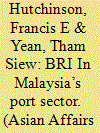

|
|
|
|
|
| Summary/Abstract |
The Belt and Road Initiative (BRI) has been characterised as a large-scale initiative to boost the movement of goods and services, capital, and people from China to Southeast Asia and beyond. Transport and logistics are a key aspect of this enterprise, with many projects focussing on railways, road networks, and ports receiving priority attention. However, BRI-related initiatives are often cast in unitary terms, with agency and autonomy almost uniquely ascribed to China-based firms and funders, and very little attributed to host country agents or their interests. Since 2013, Malaysia has received substantial inflows of BRI-related funds for infrastructure, particularly railways and ports. The Kuantan Port Expansion on Peninsular Malaysia's East Coast and the Melaka Gateway on its West Coast are two port-centred development projects associated with the BRI. Begun at the same time, these initiatives are similarly structured, as joint ventures linking large China-based state-owned enterprises with local players. Despite their similarities, these two projects have followed vastly different trajectories. While the Kuantan Port Expansion is proceeding according to schedule, the Melaka Gateway lies mired in delays and controversy. Through comparing and contrasting these two projects, this article will explore how – despite China's financial and political influence – host country actors can and do oppose, subvert, and even veto infrastructure initiatives perceived as inimical to their interests.
|
|
|
|
|
|
|
|
|
|
|
|
|
|
|
|
| 2 |
ID:
156965
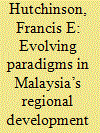

|
|
|
|
|
| Summary/Abstract |
Beyond fostering economic growth, policymakers in Malaysia have had to grapple conceptually and operationally with income inequalities between different parts of the country. Beyond its complexity, this challenge has also changed over time — in line with Malaysia’s increasing wealth and urbanization, and as understandings of what regional development is and how it should be pursued have evolved. Through a detailed study of central government planning documents and budgetary allocations, this article will analyse the targets, priorities, and approaches of Malaysian regional development policy as well as its evolution. The country’s regional policy has evolved from an a-spatial understanding of economic growth, an exclusive focus on rural development, and a “donor-recipient” approach to minimizing internal income disparities towards a deeper understanding of the relationship between location and economic activity, a greater focus on urbanization and specific cities, and a “growth oriented” approach — where all regions are encouraged to leverage their comparative advantage. While some aspects of this evolution mirror those witnessed in other countries, others may be at odds with the country’s current governance structure.
|
|
|
|
|
|
|
|
|
|
|
|
|
|
|
|
| 3 |
ID:
181824
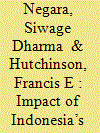

|
|
|
| 4 |
ID:
169228
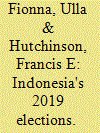

|
|
|
|
|
| Summary/Abstract |
In April 2019, Indonesia carried out simultaneous presidential and legislative elections. With an estimated 192 million voters acceding to 800,000 polling stations, this was the world's largest direct presidential election. Barring some dispersed claims of irregularities, the mammoth task of electing public representatives at the national as well as provincial and local levels was successfully carried out. Indonesia's voters had to decide on the 575 members of the national parliament, as well as some 20,000 seats in the country's many provincial and local legislatures, including 2,207 provincial level MPs from 34 provinces and 17,610 local councillors from more than 500 local authorities. Voter turn-out was an estimated 81.9 percent, the highest yet since Indonesia's transition to full democracy. Thus, at first blush, this electoral exercise can be seen as a logistical and political achievement, and an addition to Indonesia's track record of successfully-held elections. Yet, despite its technical proficiency and solid participation, the 2019 polls highlight pervasive societal and geographic fault-lines and raise questions about the strength of Indonesia's democratic institutions.
In order to analyse the importance of these elections, this article is comprised of six parts. Following this introduction, the second section briefly discusses the salient aspects of Jokowi's first administration. The subsequent part sets out the run-up to the presidential campaign, paying particular importance to changes in ‘rules of the game’ that altered the structural dynamics of the elections. The fourth section compares and contrasts the campaigns of the two opposing coalitions and the fifth analyses the electoral results. The final section concludes by discussing the denouement of the elections before looking forward.
|
|
|
|
|
|
|
|
|
|
|
|
|
|
|
|
| 5 |
ID:
161445


|
|
|
|
|
| Summary/Abstract |
The results of Malaysia’s 14th General Elections held in May this year were unexpected and transformative. Against conventional wisdom, the newly-reconfigured opposition grouping Pakatan Harapan decisively defeated the incumbent Barisan Nasional. Despite a long-running financial scandal dogging the incumbents, an opposition victory had been all but discarded due to the advantages of incumbency, a deep fissure amongst opposition ranks, and a favourable economic outlook. Notwithstanding this, deeply-rooted political dynamics and influential actors came together, reconfiguring the country’s political landscape in the process. In order to understand the elections and their implications, this article sets out the country’s institutional context and then identifies key drivers and agents of change. From there, it assesses the conduct of the elections, analyses their results, and explores implications for the future.
|
|
|
|
|
|
|
|
|
|
|
|
|
|
|
|
| 6 |
ID:
156963
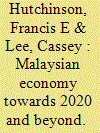

|
|
|
|
|
| Summary/Abstract |
In 1991, Malaysia’s then Prime Minister, Mahathir Mohamed, declared that the country should aim to be “fully-developed” and “industrialized” by 2020. To attain this goal, Malaysia would have to grow at an annual average of 7 per cent (in real terms) for thirty years. Prosperity and economic inclusiveness were overarching objectives, and education levels as well as scientific and technological progress were means to these ends.
|
|
|
|
|
|
|
|
|
|
|
|
|
|
|
|
|
|
|
|
|